PDF Version
Venture Capital Monitor - Q4 2014
859 KB, 6 pages
This publication by the Small Business Branch provides current information about the venture capital industry in Canada. The series will track trends in investment activity, report on topical research and look at key technology clusters where investment is taking place.
Introduction
This year-end issue covers venture capital (VC) activity from January 2014 to December 2014.
VC activity overview
Investment
Substantial increase in annual VC investment
VC investment in Canada increased significantly in 2014, compared to 2013 (Table 1). It stood at $2.36 billion, an amount higher than pre-2008 recession investment levels (Figure 1). A number of large deals contributed to the increase, including $90 million for BuildDirect Technologies Inc., $85 million for Desire2Learn, $66 million for Hootsuite Media, and $60 million for Verafin.
| FY 2013 | FY 2014 | Percent Change | |
|---|---|---|---|
| ($ millions) | |||
| Source: Thomson Reuters Canada 2015. | |||
| Investment | 1,947 | 2,364 | 21 |
| Fundraising | 1,433 | 1,220 | −15 |
Figure 1: VC Investment by year, 2005–14
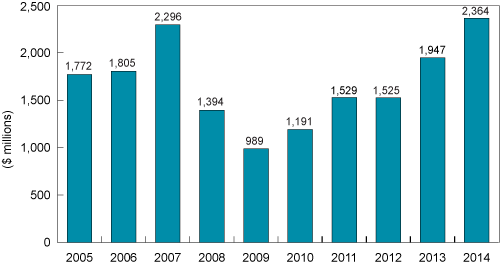
Source: Thomson Reuters Canada 2015.
Fundraising
The amount committed to Canadian VC funds totalled $1.2 billion in 2014, down from the $1.4 billion committed in 2013
As in past years, government-backed sources accounted for the majority of capital raised by Canadian VC funds in 2014, accounting for $832 million or more than two-thirds of total commitments (Figure 2). These government-backed investors are as follows:
- Retail funds, which are supported by government tax credits, raised $400 million to invest directly in companies;
- Funds of funds sources committed $250 million to private independent funds, and many of these funds of funds are backed by governments;
- Government sources committed $183 million, mostly to private independent funds.
Figure 2: Commitments to Canadian VC funds by source of capital, 2014
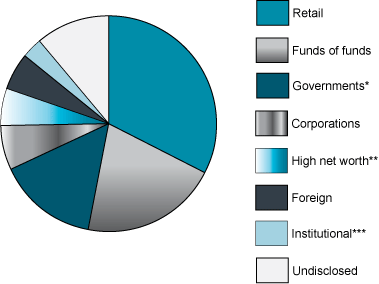
Note * of Figure 2: Government sources in recent years include the Business Development Bank of Canada, Export Development Canada, Farm Credit Canada, and several provincial government organizations.
Note ** of Figure 2: High-net-worth individuals who invest in venture capital funds.
Note *** of Figure 2: Institutional investors comprise of public and private pension funds, insurance companies, and endowment funds.
Source: Thomson Reuters Canada 2015.
Aside from those government-backed investors, $255 million in private capital was committed to Canadian VC funds by sources including corporations, high-net-worth individuals, foreign investors, and institutional funds. An additional $133 million was invested in VC funds by undisclosed sources.
Deal size
Slight increase in the average deal size in 2014
There were 522 deals in 2014, 12 percent higher than the 468 deals closed in 2013. The average deal size was $4.53 million in 2014, compared to $4.16 million in 2013, an 8.8 percent year-over-year increase.
The total number of VC deals under $1 million slightly decreased in 2014 with 269 deals reported, compared to the 274 deals reported in 2013 (Figure 3). The total number of deals under $1 million represented half (51 percent) of all deals completed in 2014.
Figure 3: Distribution of VC investment by deal size, 2012–14
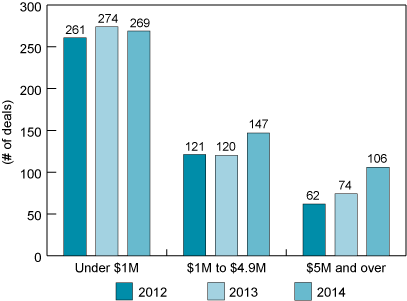
Source: Thomson Reuters Canada 2015.
The number of VC deals between $1 million and $4.9 million in 2014 increased by 22 percent, compared to 2013, with 147 deals reported. The number of deals in this category reported in 2012 and 2013 were 121 and 120, respectively.
VC deals of $5 million and over category experienced a notable increase in 2014 to 106 deals from the 74 deals registered in 2013 and 62 deals for in 2012.
Stage of development
Investment grows in both early and later stages of development
Later stage investment in 2014 was $1.30 billion, a 22 percent increase compared to the $1.06 billion reported in 2013 (Figure 4). Overall, later stage investments represented 54 percent of all VC investment in 2014, a similar share to the years 2012 and 2013. Seed and early stage companies attracted $602 million in VC investment in 2014, a 53 percent increase compared to the $392 million they attracted in 2013. Expansion stage companies attracted $466 million in VC investment in 2014, an amount 5.4 percent lower than the $493 million invested in this type of company in 2013.
Figure 4: VC investment by stage of development, 2012—14

Note * of Figure 4: In addition to later stage deals, this category includes public market and acquisitions financing.
Source: Thomson Reuters Canada 2015.
New versus follow-on investments
The number of follow-on deals substantially increased while it declined for new deals
Out of the 522 deals completed in 2014, there were 181 new deals and 341 follow-on deals (Table 2). New deals decreased in 2014 by 14 percent compared to 2013, while the reverse is observed for follow-on deals, which increased by a substantial 33 percent during the same period.
| Total Investment | 2012 | 2013 | 2014 | |
|---|---|---|---|---|
| Source: Thomson Reuters Canada 2015. | ||||
| New | Seed and early stage | 104 | 130 | 108 |
| Expansion | 39 | 29 | 30 | |
| Later stage | 34 | 53 | 43 | |
| All | 177 | 212 | 181 | |
| Follow-on | Seed and early stage | 61 | 66 | 97 |
| Expansion | 101 | 71 | 76 | |
| Later stage | 105 | 119 | 168 | |
| All | 267 | 256 | 341 | |
| Total | 444 | 468 | 522 | |
New deals in seed and early stage companies decreased between 2013 and 2014 by 16 percent, from 130 deals to 108. New later stage deals also decreased from 53 to 43 during the same period, while expansion stage remained at the same level.
Follow-on deals in later stage companies increased by 40 percent between 2013 and 2014, from 119 deals in 2013 to 168 deals in 2014. The same trend is observed in follow-on seed and early stage deals, with 97 deals completed in this category in 2014 compared to 66 in 2013, a 46 percent year-over-year increase. Follow-on deals in the expansion experienced a slight increase of 7 percent during the same period.
Type of investor
VC investment by private independent funds show a slight year-over-year increase
Private independent funds invested $906 million in 2014, an increase of 5 percent compared to the $859 million invested in 2013 (Figure 5). Direct government VC investment remained stable in 2014 at $162 million, compared to $164 million in 2013. VC investment from undisclosed sources was substantial, totalling $806 million in 2014. Of the investment with disclosed sources, 58 percent was made by private independent funds.
Figure 5: Distribution of VC investment by type of investor, 2012–14
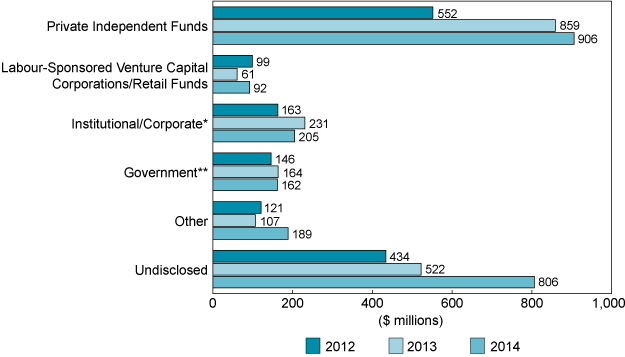
Note * of Figure 5: Institutional/Corporate refers to direct investments by banks, financial institutions, endowments, foundations, pension funds and corporate venture funds.
Note ** of Figure 5: Government investors in recent years include the Business Development Bank of Canada, Ontario's Investment Accelerator Fund, Nova Scotia First Fund, and several other federal and provincial organizations.
Source: Thomson Reuters Canada 2015.
Source of funds
Domestic investors experiences faster growth
Investment from Canadian VC funds increased to $1.12 billion in 2014, from the $954 million reported in 2013, a 17 percent year-over-year increase (Figure 6). In contrast VC investment from the United States decreased by 7 percent during the same period, from $758 million in 2013 to $712 million in 2014. VC investment from undisclosed countries was substantial, totalling $442 million in 2014. Of the disclosed investment, 59 percent was made by Canadian VC funds.
Figure 6: Distribution of VC investment by fund location, 2012–14
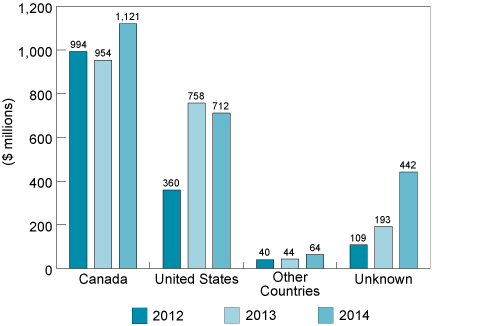
Source: Thomson Reuters Canada 2015.
Regional distribution
Ontario had a substantial 34 percent increase in VC investment
Ontario attracted $906 million in VC investment in VC investment in 2014, a 34 percent increase compared to the $675 million invested in the province in 2013 (Figure 7). This increase is largely due to a number of large deals, such as Desire2Learn, WP Technologies, Kik Interactive, and MedAvail Technologies, which between the four of them attracted $206 million in VC investment. As in previous years, Quebec was the second largest destination of VC investment in Canada in 2014, attracting $604 million, a slight 1 percent increase compared to the $596 million invested in the province in 2013. British Columbia and Alberta continued their growth trajectory, observed last year. British Columbia attracted $506 million in VC investment in 2014, a 26 percent increase compared to the $400 million the province attracted in 2013, while Alberta VC investment grew by 31 percent from $161 million reported in 2013 to $213 million reported in 2014.
Figure 7: Regional distribution of VC investment in Canada, 2012–14
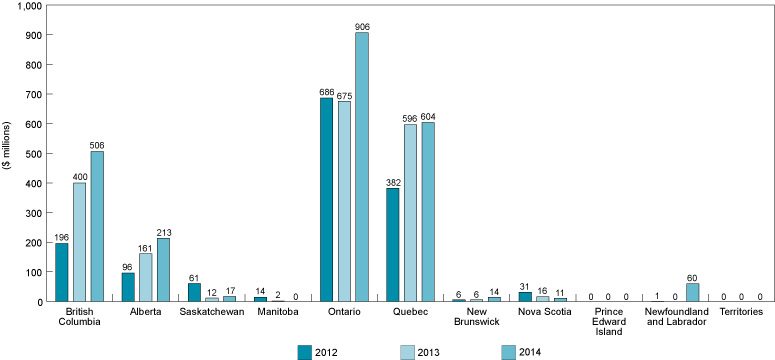
Source: Thomson Reuters Canada 2015.
While Ontario attracted the largest amount of VC in 2014, Quebec was the province with the highest number of companies receiving VC financing with 151, a slight decrease from the 154 reported in 2013 (Table 3). There were 142 companies funded in Ontario, 60 in British Columbia and 27 in Alberta.
| Province | 2013 | 2014 | Percent Change |
|---|---|---|---|
| Source: Thomson Reuters Canada 2015. | |||
| British Columbia | 51 | 60 | 18 |
| Alberta | 26 | 27 | 4 |
| Saskatchewan | 4 | 4 | 0 |
| Manitoba | 1 | 1 | 0 |
| Ontario | 139 | 142 | 2 |
| Quebec | 154 | 151 | −2 |
| New Brunswick | 14 | 19 | 36 |
| Nova Scotia | 12 | 9 | −25 |
| Prince Edward Island | 0 | 1 | n/a |
| Newfoundland & Labrador | 1 | 2 | 100 |
| Territories | n/a | n/a | n/a |
Sector distribution
VC investment in the information technology sector posted strong year-over-year growth
Information technology (IT) companies continued to be the main recipient of VC investment, as in previous years. VC Investment in the IT sector was $1.45 billion in 2014, a 38 percent increase compared to the $1.05 billion reported in 2013 (Figure 8). This increase can be explained in part by very large deals completed in the sector during 2014, such as BuildDirect Technologies, Desire2Learn, WP Technologies, Kik Interactive, and HootSuite Media.
Figure 8: VC investment by industry sector, 2012–14
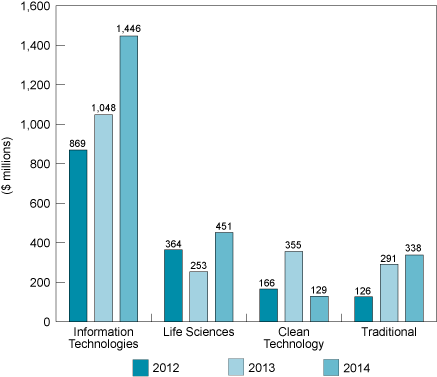
Source: Thomson Reuters Canada 2015.
The life sciences sector also posted remarkable growth in 2014, with an increase of 78 percent from $253 million reported in 2013 to $451 million in 2014.
Government activities
Business Development Bank of Canada activities
During Q4 2014, the Business Development Bank of Canada (BDC) committed $18.4 million in 25 companies. It leveraged an additional $42.4 million from other investors, bringing the total investment in these companies to $60.7 million (Table 4). This brings the BDC VC commitments in 2014 to $83 million in 92 companies, with an additional $247 million leveraged from co-investors.
| BDC | Co-investors | Total | Number of Companies | |
|---|---|---|---|---|
| ($ millions) | ||||
| Source: Source: Business Development Bank of Canada 2015. | ||||
| Seed/start-up | 6.7 | 17.3 | 24.0 | 20 |
| Development | 9.4 | 23.5 | 32.9 | 3 |
| Later stage | 2.3 | 1.6 | 3.9 | 2 |
| Total | 18.4 | 42.4 | 60.7 | 25 |
In terms of the BDC's indirect investment, in Q4 2014 it placed $37 million into a number of Canadian VC funds. With other co-investors, the BDC helped these funds raise a total of $155 million. This brings the BDC's indirect investment into Canadian funds in 2014 to $126 million. With support from the BDC and its partners, these funds raised a total of $696 million in funding.
Other government activities
In Q4 2014, two new funds of funds were established under the Government of Canada's Venture Capital Action Plan. First, the Teralys Capital Innovation Fund had an initial closing with $279 million in commitments—$186 million from institutional and corporate investors, alongside $46.5 million from each of the governments of Canada and Quebec. Second, the Kensington Venture Fund had an initial closing with $160 million in commitments—$107 million from institutional, corporate and individual investors, alongside $53 million from the Government of Canada.
Notes
This publication is part of a series prepared by the Small Business Branch. The branch analyses the financialmarketplace and how trends in this market impact small businesses' access to financing.
To be added to the distribution list of online release of the Small Business Branch publications, please subscribe at the Subscribe to publications page.
For questions related to its content, please email: SBB-DGPE.
Copyright
To obtain a copy of this publication or an alternate format (Braille, large print, etc.), please fill out the PublicationRequest form at Publication Request form or contact the:
Web Services Centre
Industry Canada
C.D. Howe Building
235 Queen Street
Ottawa, ON K1A 0H5
Canada
Telephone (toll-free in Canada): 1-800-328-6189
Telephone (Ottawa): 613-954-5031
TTY (for hearing-impaired): 1-866-694-8389
Business hours: 8:30 a.m. to 5:00 p.m. (Eastern Time)
Email: ic.info-info.ic@canada.ca
Permission to Reproduce
Except as otherwise specifically noted, the information in this publication may be reproduced, in part or in wholeand by any means, without charge or further permission from Industry Canada, provided that due diligence is exercised in ensuring the accuracy of the information reproduced; that Industry Canada is identified as the source institution; and that the reproduction is not represented as an official version of the information reproduced, nor as having been made in affiliation with, or with the endorsement of, Industry Canada.
For permission to reproduce the information in this publication for commercial purposes, please fill out theApplication for Crown Copyright Clearance at Application for Crown Copyright Clearance or contact the Web Services Centre (see contact information above).
© Her Majesty the Queen in Right of Canada,
as represented by the Minister of Industry, 2015
Aussi offert en français sous le titre Le Moniteur du capital de risque — Quatrième trimestre de 2014.
